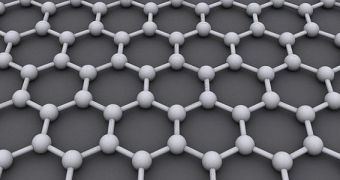Scientists from the Karlsruhe Institute of Technology, in Germany, and the French National Center for Scientific Research (CRNS) say that graphene can potentially be used to create a tool capable of focusing electrons. The instrument would work just like an optical lens does for light.
In a paper published in the American Institute of Physics' (AIP) journal Applied Physics, the team explains that graphene can produce this guiding effect for electrons only when its properties are changed through stretching. The 2D carbon compound is the toughest material ever discovered.
The graphene lens was built from a silicon-carbide wafer, through which a series of nanoscale, hexagonal holes were drilled. A layer of compound was then lowered onto the wafer, producing what experts refer to as a “deformed graphene carpet.” e! Science News reports.
Portions of the graphene sheet that covered the holes were deformed, and started acting as electron lenses. A series of practical applications exist for this construct, including in new, high-speed electronics.

 14 DAY TRIAL //
14 DAY TRIAL //